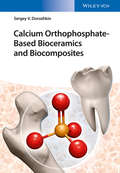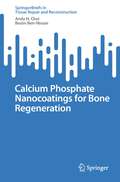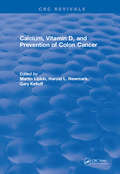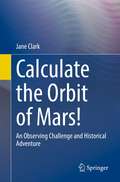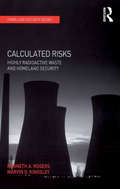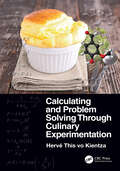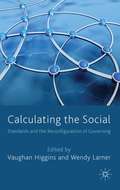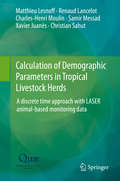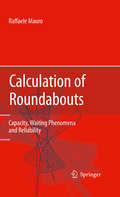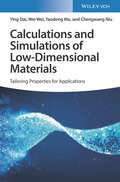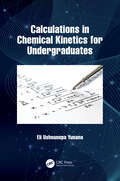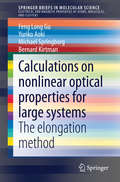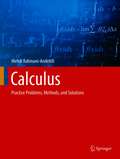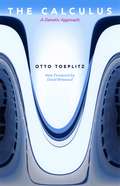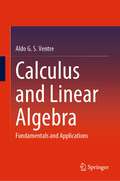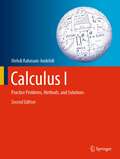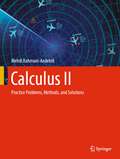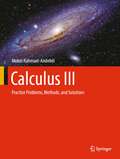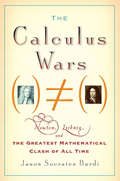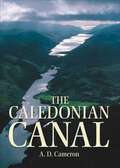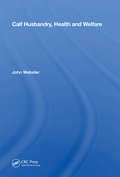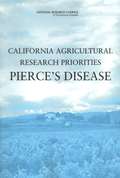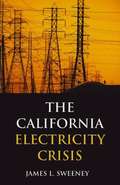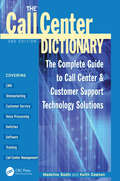- Table View
- List View
Calcium Orthophosphate-Based Bioceramics and Biocomposites
by Sergey V. DorozhkinReflecting the advances made in recent years, this is a comprehensive overview of calcium orthophosphates for bioceramics and biocomposites with a special focus on the detailed description of all those available, including their biological and geological occurrence, preparation, chemical composition, structure-property relationships and applications. In particular, the book discusses the suitability of these orthophosphates for biomedical applications and their use as bone grafts in surgery and medicine. The result is a useful reference for researchers with an academic, medical or commercial background.
Calcium Phosphate Nanocoatings for Bone Regeneration (Tissue Repair and Reconstruction)
by Andy H. Choi Besim Ben-NissanThis book provides in-depth assessment on the latest clinical advances in multifunctional calcium phosphate nanocoatings and its influence on bone regeneration and early healing following implantation. A greater emphasis will be placed on the use of nanocomposite coatings to deliver biological materials such as mesenchymal stem cells, growth factors, bone morphogenetic and extracellular matrix proteins, and pharmaceutics such as simvastatin to improve and promote bone growth as well as reducing the timeframe needed for implant integration in both healthy and osteoporotic patients. The content of the book caters to clinical practitioners and researchers working in the field of biomaterials for bone regeneration.
Calcium, Vitamin D, and Prevention of Colon Cancer
by Martin LipkinThese proceedings were published as a result of a workshop sponsored by the Chemoprevention Branch of the National Cancer Institute. The workshop covered a range of topics including calcium and vitamin D in human nutrition; epidemiologic relationships betweencalcium, vitamin D, and colon cancer; the biology of calium and vitamin D at the tissue and cellular level; and enimal and human studies investigating the potential for prevention of colon cancer with calcium and vitamin D.
Calculate the Orbit of Mars!: An Observing Challenge and Historical Adventure
by Jane ClarkThis book shows readers how to calculate the orbit of Mars, based on their own observations and using observations made by the author. The historical, observational, and analytical aspects of the project to measure the orbit of Mars are all combined in this one book!Determining the orbit of Mars is particularly important, as originally solving this problem required the founding of modern science. Clark discusses how people came to believe in the Newtonian model of the Solar System, works through the mathematical basis for the theory of gravity, and shows how Newton ruled out the possibility of alternative theories. Readers also learn how it became possible to accurately measure the positions of Mars from a moving, spinning platform—the Earth.This mid-level observational challenge is well within reach of most serious amateur astronomers. For the observations, only a telescope with auto-guiding capability and the ability to mount a digital single lens reflex (DSLR) camera is required. For the calculations, it is assumed that the reader has a science, engineering, or mathematics background and is familiar with calculus, vectors, and trigonometry.
Calculated Risks: Highly Radioactive Waste and Homeland Security (Homeland Security)
by Kenneth A. Rogers Marvin G. KingsleyThis well-documented study examines one of the increasingly pressing problems for US homeland security: the storage and management of radioactive waste. Despite pressing homeland security and energy security concerns associated with highly radioactive waste, political considerations have prevented policy makers from adopting adequate long-term solutions to the problem. This book explores nuclear waste problems through the broader lens of federal, state and local government and the resultant constraints on policy that emerge within the American political system. Presenting specific case studies to highlight the deficiencies in current policy and planning as well as the possibility of terrorist activity, it is highly suited to courses on security studies and environmental politics.
Calculating and Problem Solving Through Culinary Experimentation
by Hervé This vo KientzaWhile many books proliferate elucidating the science behind the transformations during cooking, none teach the concepts of physics chemistry through problem solving based on culinary experiments as this one by renowned chemist and one of the founders of molecular gastronomy. Calculating and Problem Solving Through Culinary Experimentation offers an appealing approach to teaching experimental design and scientific calculations. Given the fact that culinary phenomena need physics and chemistry to be interpreted, there are strong and legitimate reasons for introducing molecular gastronomy in scientific curriculum. As any scientific discipline, molecular gastronomy is based on experiments (to observe the phenomena to be studied) and calculation (to fit the many data obtained by quantitative characterization of the studied phenomena), but also for making the theoretical work without which no real science is done, including refuting consequences of the introduced theories. Often, no difficult calculations are needed, and many physicists, in particular, make their first steps in understanding phenomena with very crude calculations. Indeed, they simply apply what they learned, before moving to more difficult math. In this book, the students are invited first to make simple experiments in order to get a clear idea of the (culinary) phenomena that they will be invited to investigate, and then are asked simple questions about the phenomena, for which they have to transform their knowledge into skills, using a clear strategy that is explained throughout. Indeed, the is "problem solving based on experiments", and all this about food and cooking. Key Features: • Introduces readers to tips for experimental work • Shows how simple scientific knowledge can be applied in understanding questions • Provides a sound method ("strategy") for calculation in physics and chemistry • Presents important definitions and laws for physical chemistry • Gives confidence in one’s calculation skill and problem solving skills • Explore physical and chemical phenomena that occur during cooking A unique mix of culinary arts and correct calculations, this book is useful to students as well as professors in chemistry, physics, biology, food science and technology.
Calculating the Social
by Vaughan Higgins Wendy LarnerExamining the increasingly powerful role of standards in the governing of economic, political and social life, this book draws upon governmentality and actor network theory to explore how standards and standardizing projects are articulated and rendered workable in practice, and the objects, subjects and forms of identity to which this gives rise.
Calculation of Demographic Parameters in Tropical Livestock Herds: A discrete time approach with LASER animal-based monitoring data
by Matthieu Lesnoff Renaud Lancelot Charles-Henri Moulin Samir Messad Xavier Juanès Christian SahutHaving indicators to assess the effect of zootechnical, sanitary, economic or political intervention or the impact of environmental risks makes it possible to draw up strategies for improving domestic animal populations. This handbook is a compilation of the main concepts relating to the definition and calculation of demographic rates for largely non-intensive tropical animal farms. It is intended to be educational, and should help students, technicians, engineers, researchers and development staff to understand the definitions and formulas encountered in the literature more clearly and make them more self-sufficient in terms of analyses.
Calculation of Roundabouts: Capacity, Waiting Phenomena and Reliability
by Raffaele MauroRoundabouts have become one of the most significant traffic control measures because they are generally statistically safer and more efficient than traditional at grade intersections. This book is dedicated to the evaluation of the operating conditions of roundabouts. In five parts, it thoroughly illustrates the calculation of the capacity, including reliability, and waiting phenomena parameters, such as the times spent in the system and queue lengths. Fully worked examples are included throughout the chapters, with detailed explanations.
Calculations and Simulations of Low-Dimensional Materials: Tailoring Properties for Applications
by Ying Dai Wei Wei Yandong Ma Chengwang NiuCalculations and Simulations of Low-Dimensional Materials A comprehensive guide to methods for calculating and simulating the properties of low-dimensional materials Two-dimensional materials are those, such as graphene and 2D oxides, whose thickness is so small as to approach the atomic scale. Potential applications for these materials exist in an enormous range of scientific and industrial fields. A previous era of low-dimensional materials focused on direct experimentation to demonstrate the properties, reactions, and potential applications of these materials; however, in recent years, calculation and simulation have been shown to have considerable predictive power, reducing the period between design and deployment of these potentially critical materials. Calculations and Simulations of Low-Dimensional Materials offers the first comprehensive survey of this exciting new approach to low-dimensional materials. It guides readers through the foundational physics and through a range of calculation and simulation methods, each with different predictive capacities. Mastery of these methods will enable readers to narrowly tailor the properties of particular materials towards real-world applications, providing confidence in the underlying mechanics and in the range of possible outcomes. Calculations and Simulations of Low-Dimensional Materials readers will also find: Broad coverage of material properties, including electronic, spin, magnetic, photonic, optical, electrochemical and transport properties Discussion of potential applications in areas such as electronics, spintronics, and valleytronics Examination of further potential applications regarding quantum Hall phase, photonics, optoelectronics, multiferroic, and photocatalysis Calculations and Simulations of Low-Dimensional Materials is a useful reference for materials scientists, electrochemists, inorganic chemists, physical chemists, photochemists, and the libraries that support these professions.
Calculations in Chemical Kinetics for Undergraduates
by Eli Usheunepa YunanaCalculations in Chemical Kinetics for Undergraduates aims to restore passion for problem solving and applied quantitative skills in undergraduate chemistry students. Avoiding complicated chemistry jargon and providing hints and step wise explanations in every calculation problem, students are able to overcome their fear of handling mathematically applied problems in physical chemistry. This solid foundation in their early studies will enable them to connect fundamental theoretical chemistry to real experimental applications as graduates. Additional Features Include: Contains quantitative problems from popular physical chemistry references. Provides step by step explanations are given in every calculation problem. Offers hints to certain problems as "points to note" to enable student comprehension. Includes solutions for all questions and exercises. This book is a great resource for undergraduate chemistry students however, the contents are rich and useful to even the graduate chemist that has passion for applied problems in physical chemistry of reaction Kinetics.
Calculations on nonlinear optical properties for large systems: The elongation method (SpringerBriefs in Molecular Science)
by Feng Long Gu Yuriko Aoki Michael Springborg Bernard KirtmanFor design purposes one needs to relate the structure of proposed materials to their NLO (nonlinear optical) and other properties, which is a situation where theoretical approaches can be very helpful in providing suggestions for candidate systems that subsequently can be synthesized and studied experimentally. This brief describes the quantum-mechanical treatment of the response to one or more external oscillating electric fields for molecular and macroscopic, crystalline systems. To calculate NLO properties of large systems, a linear scaling generalized elongation method for the efficient and accurate calculation is introduced. The reader should be aware that this treatment is particularly feasible for complicated three-dimensional and/or delocalized systems that are intractable when applied to conventional or other linear scaling methods.
Calculus: Practice Problems, Methods, and Solutions
by Mehdi Rahmani-AndebiliThis study guide is designed for students taking courses in calculus. The textbook includes practice problems that will help students to review and sharpen their knowledge of the subject and enhance their performance in the classroom. Offering detailed solutions, multiple methods for solving problems, and clear explanations of concepts, this hands-on guide will improve student’s problem-solving skills and basic understanding of the topics covered in their calculus courses.Exercises cover a wide selection of basic and advanced questions and problems;Categorizes and orders the problems based on difficulty level, hence suitable for both knowledgeable and under-prepared students;Provides detailed and instructor-recommended solutions and methods, along with clear explanations;Can be used along with core calculus textbooks.
The Calculus: A Genetic Approach
by Otto ToeplitzWhen first published posthumously in 1963, this bookpresented a radically different approach to the teaching of calculus. In sharp contrast to the methods of his time, Otto Toeplitz did not teach calculus as a static system of techniques and facts to be memorized. Instead, he drew on his knowledge of the history of mathematics and presented calculus as an organic evolution of ideas beginning with the discoveries of Greek scholars, such as Archimedes, Pythagoras, and Euclid, and developing through the centuries in the work of Kepler, Galileo, Fermat, Newton, and Leibniz. Through this unique approach, Toeplitz summarized and elucidated the major mathematical advances that contributed to modern calculus. Reissued for the first time since 1981 and updated with a new foreword, this classic text in the field of mathematics is experiencing a resurgence of interest among students and educators of calculus today.
Calculus and Linear Algebra: Fundamentals and Applications
by Aldo G. VentreThis textbook offers a comprehensive coverage of the fundamentals of calculus, linear algebra and analytic geometry. Intended for bachelor’s students in science, engineering, architecture, economics, the presentation is self-contained, and supported by numerous graphs, to facilitate visualization and also to stimulate readers’ intuition. The proofs of the theorems are rigorous, yet presented in straightforward and comprehensive way. With a good balance between algebra, geometry and analysis, this book guides readers to apply the theory to solve differential equations. Many problems and solved exercises are included. Students are expected to gain a solid background and a versatile attitude towards calculus, algebra and geometry, which can be later used to acquire new skills in more advanced scientific disciplines, such as bioinformatics, process engineering, and finance. At the same time, instructors are provided with extensive information and inspiration for the preparation of their own courses.
Calculus, Concepts and Calculators (Second Edition)
by George Best Stephen Carter Douglas CrabtreeThis book covers all the topics that are included in the new AP calculus course description,focusing on conceptual understanding and thinking skills.
Calculus I: Practice Problems, Methods, and Solutions
by Mehdi Rahmani-AndebiliThis study guide is designed for students taking a Calculus I course. This new edition includes expanded examples, questions, and practice problems that will help students to review and sharpen their knowledge of the subject and enhance their performance in the classroom. New material covered in the second edition includes types of functions, inverse functions, combinations of functions, domain and range of functions, axis of symmetry of functions, trigonometric equations and identities, limits and continuity, derivatives and their applications, and definite and indefinite integrals. Offering detailed solutions, multiple methods for solving problems, and clear explanations of concepts, this hands-on guide will improve students’ problem-solving skills and foster a solid understanding of calculus, which will benefit them in all of their calculus-based courses.
Calculus II: Practice Problems, Methods, and Solutions
by Mehdi Rahmani-AndebiliThis study guide is designed for students taking a Calculus II course. The textbook includes examples, questions, and practice problems that will help students to review and sharpen their knowledge of the subject and enhance their performance in the classroom. The material covered in the book includes applications of integration, sequences and series and their applications, polar coordinate systems, and complex numbers. Offering detailed solutions, multiple methods for solving problems, and clear explanations of concepts, this hands-on guide will improve students’ problem-solving skills and foster a solid understanding of calculus, which will benefit them in all of their calculus-based courses
Calculus III: Practice Problems, Methods, and Solutions
by Mehdi Rahmani-AndebiliThis study guide is designed for students taking a Calculus III course. The textbook includes examples, questions, and practice problems that will help students to review and sharpen their knowledge of the subject and enhance their performance in the classroom. The material covered in the book includes linear algebra and analytical geometry; lines, surfaces, and vector functions in three-dimensional coordinate systems; multiple-variable functions; multiple integrals and their applications; line integrals and their applications. Offering detailed solutions, multiple methods for solving problems, and clear explanations of concepts, this hands-on guide will improve students’ problem-solving skills and foster a solid understanding of calculus, which will benefit them in all of their calculus-based courses.
The Calculus Wars: Newton, Leibniz, and the Greatest Mathematical Clash of All Time
by Jason Socrates BardiThis vibrant and gripping history ultimately exposes how these twin mathematical giants (Newton, Leibniz) were proud, brilliant, at times mad, and in the end completely human.
The Caledonian Canal: In The Great Glen
by A.D. CameronAn exploration of the history of the sixty-mile, Scottish Highland canal and its significance to the region&’s transportation and tourism. Thomas Telford&’s plan, to connect Loch Ness, Loch Oich, and Loch Lochy with each other and the sea, was a huge undertaking that brought civil engineering to the Highlands on a heroic scale. Deep in the Highlands, far from the canal network of England, engineers forged their way through the Great Glen to construct the biggest canal of its day: twenty-two miles of artificial cutting and no fewer than twenty-eight locks. A.D. (Sandy) Cameron&’s book has long been recognized as the authoritative work on the canal as well as a reliable and useful guide to the surrounding area. There are intriguing old plans, not discovered until 1992, and a survey of the dramatic rise in pleasure-craft traffic during the last two decades. But the highlight of the recent past was undoubtedly the Tall Ships passing through the canal in stately procession in 1991. Impossible, then, not to feel the fascination of this beautiful waterway: a working piece of industrial history and a remarkable engineering achievement. This book is a fitting celebration of this remarkable feat of engineering.
Calf Husbandry, Health And Welfare
by John WebsterToo many calves die young or fail to survive at the cost of enormous financial loss and suffering. Good calf performance and health can be achieved if the stockmanship is good. Today this implies not only a sense of care but a thorough science-based education. Aimed at both students and stockmen, this book explains the scientific basis of calf-rear
California Agricultural Research Priorities Pierce's Disease
by Committee on California Agricultural Research Priorities: Pierce's DiseaseThe glassy-winged sharpshooter is one of the more recent invasive pests to afflict California agriculture. The insect transmits a bacterial pathogen that causes Pierce's disease, which has impaired production of wine, table, and raisin grapes in California. The report recommends strengthening the process and the priorities for research funded by state agencies and wine industry groups to address Pierce's disease and its vector. Research should be focused on identifying feasible options for controlling the spread of the disease and providing sustainable approaches that are adaptable and affordable over the long term. Several avenues of research be pursued more intensely including the genetic makeup of the pathogen that triggers Pierce's disease, understanding the mechanisms that make grapes resistant to the disease, the possibilities of introducing predator enemies to the sharpshooter, and new ways to manage the planting of crops to help avoid spread of the disease.
The California Electricity Crisis
by James L. SweeneySweeney addresses four main topics: the current situation in California, the history of California's energy, the consequences of decisions that are being made, and what we should or shouldn't do about it.
The Call Center Dictionary: The Complete Guide to Call Center and Customer Support Technology Solutions
by Madeline BodinCall centres have become the crucial front line for managing customer relationships. This book covers a range of call center terminology. It explains relevant terms, and provides the call center manager with a quick reference that covers the technology and operational issues that come up in running and improving a call center.
